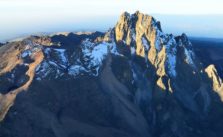By Walter Pepela
Mount Kenya is the tallest mountain in Kenya and most famed for its snow capped peak that is a marvel to tourists and lovers of nature. The mountain has vegetation that is called alpine vegetation and the areas around the top are too cold to support large plants. The progression of vegetation on the mountain is described below;
Savannah
It is found at the foot of the mountain about 2000 meters above the sea level. The vegetation is scrub and short grass. The vegetation increases with the increase in altitude to form Savannah woodland.
Rain forest
This forest starts above the Savannah belt. Trees are of less height and density compared to equatorial rain forests. The heights of the trees reduce with increase in altitude and examples of tree species on the mountain are camphor and cedar.
Temperate forest
This zone is found above the rain forest and the vegetation is characterized by coniferous and deciduous plants examples are oak, chestnut and pines. Other undergrowth are mosses and lichens.
Bamboo forest
To the top of Mt Kenya, there are a lot of bamboo forests which form very dense thickets.
Heath and moorland
Above the height of about 3 500 m and the vegetation consists of mainly groundsels, tussock grass and lobelia. This vegetation is referred to as the heath and moorland.
These vegetation on mount Kenya is important because it is a home for a wide variety of wild animals which attract tourists and it is also a center for conservation of biodiversity because a wide range of species of both plants and animals are located on the mountain.
This article has been written by Kenyayote Guest Blogger. For More information contact him on
coffindancer16@gmail.com


Leave a Reply